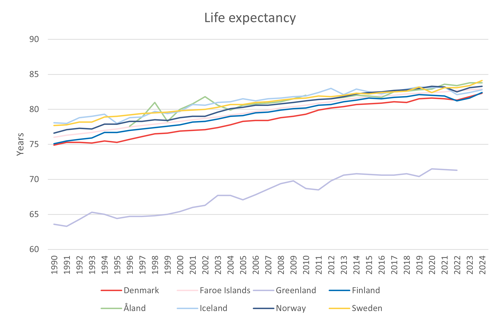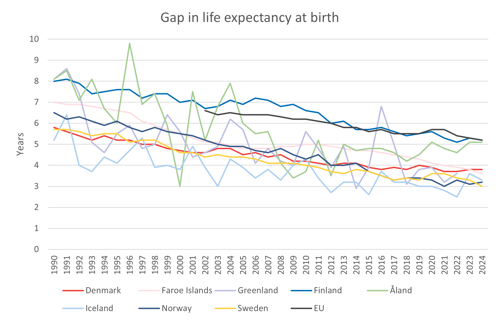Nordic life expectancy hits 83.2 years, exceeding pre-pandemic level
In 2024, life expectancy at birth in the Nordics was 83.2 years, an increase of 0.6 years from 2023 and for the first time exceeding pre-pandemic levels. Life expectancy in the respective countries ranged from 82.3 (Denmark) to 84.1 years (Sweden), with the exception of Greenland which stood out with 71.3 years. The gap in life expectancy between men and women is steadily decreasing.
Life measures the average number of years that a person can expect to live, if the mortality levels remain constant, and it is increasing. Since the beginning of the 21st century, all Nordic countries and regions except Greenland have passed the 80-year threshold for life expectancy at birth. Åland was the first region to reach the threshold in 2000, followed by Iceland in 2001, Sweden in 2003, Norway in 2004, Faroe Islands in 2008, Finland in 2009 and Denmark in 2012. Greenland passed the 70-year threshold in 2013.
In 2024, life expectancy at birth in the Nordics was 83.2 years [1], an increase of 0.6 years from 2023. After having declined due to the COVID-19 pandemic, life expectancy has now reached values higher than in 2019. The 2024 value was also the highest recorded since 2002, reflecting a total increase of 4.4 years. For comparison, the EU life expectancy in 2024 was 81.7, with a total increase of 4.1 years since 2002.
It is also worth noting that the decline in life expectancy during the pandemic years was greater in the EU than it was in the Nordic countries, and that life expectancy has also increased faster in the Nordic countries in recent years.

In 2024, life expectancy in the Nordics ranged from 82.3 to 84.1 years, with the exception of Greenland which stood out with 71.3 years [2]. This means that for all countries except for Iceland, life expectancy now exceeds pre-pandemic (2019) levels.
Of the five larger Nordic countries, Denmark had the lowest life expectancy in 2024 (82.3 years), closely followed by Finland (82.4 years). Sweden had the highest value (84.1 years), while Iceland and Norway place in the middle with 82.8 and 83.3 years, respectively. All five countries have had similar increases for the past decades.
Considering the period from 1990 and forward, the life expectancy for Greenland increased until 2013 when it stagnated. It remained at the same level for a long time, only starting to rise again in the last few years. The life expectancy for the Faroe Islands has been steadily increasing and is today close to the Nordic aggregate. Life expectancies for Åland have been fluctuating but always found in the upper part of the spectre.

Source: LIFE01
Further, the gap in life expectancy between men and women is decreasing in all Nordic countries. The gap indicates the difference in years between men and women, measured as the gap towards women (women tend to live longer). In 1990, life expectancy was between 5.2 (Iceland) and 8.1 years (Åland) higher for women than for men. In 2024, the gap ranged from 3.0 years (Sweden) to 5.2 years (Finland). This can be compared to the EU value of 5.2 years in 2024.

Source: LIFE02
Please note that in countries with smaller populations, the fluctuation between years is naturally larger, giving a more volatile impression.
______________________________________________________________________________
[1] The Nordic Region aggregate is comprised of the following countries/areas: Denmark, Faroe Islands, Greenland, Finland, Åland, Iceland, Norway and Sweden. As 2024 values are yet to be published, 2022 values are used for Greenland, and 2023 values are used for Åland.
[2] Please be advised that the Greenland data is under review and will be updated by the end of October, including a source change.